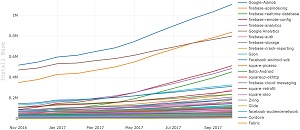News
Fastest-Growing SDKs Predict 2018 Trends in Android Development
- By David Ramel
- January 2, 2018
Because one of the best ways to see where something is going is to track where it's coming from, Android developers interested in what 2018 has in store can consult a new report on the fastest-growing SDKs of 2017.
The report comes from mobile app intelligence and data company MightySignal, which claims to scan all mobile app releases and updates to identify the SDKs in use. Last year, the company issued a similar report focusing on iOS development, in which it identified Twitter Inc.'s Fabric as a hot dev tool, edging out offerings from larger and more established players such as Google and Adobe.
This year, the company focused on Android development, and changed its methodology in order to lump all SDKs together rather than segment them out by different categories such as analytics and monetization.
"We believe this provides a new and exciting way to identify mobile trends," the company said in a blog post. "As a developer, you can now see how your peers have changed their approach to building apps over the past year and what new tools they’re implementing. We hope this unearths new opportunities and resources that you can leverage in creating your own, unique app."
One not-so-new tool they're still implementing is Google's AdMob SDK, for mobile app monetization and in-app advertising, which clocks in as the overall No. 1 SDK for Android in 2017 by a wide margin. Google claims AdMob is used in more than 1 million apps and serves more than 200 billion ad requests per month.
Another Google offering, the Firebase back-end system, also made a strong showing, demonstrating the second-most absolute growth over the past year (the MightySignal tool also lets users visualize relative growth to shed insights on more obscure products). Firebase provides server-side functionality for mobile apps, such as crash reporting, analytics and so on.
 [Click on image for larger view.]
Fastest-Growing Android SDKs (source: MightySignal)
[Click on image for larger view.]
Fastest-Growing Android SDKs (source: MightySignal)
While AdMob led the Monetization category in addition to the overall ranking, Firebase-related services led the other categories, including App Performance Management (firebase-crash-reporting), Analytics (firebase-analytics), App Platform (firebase-appindexing) and Backend (firebase-realtime-database).
Based on its collected data, MightySignal identified four mobile development trends to keep an eye on for 2018, one of which was the choice of single dev platforms (SDKs that provide multiple functionalities) over specialized SDKs that focus on one bit of functionality.
"As a developer, keep in mind that between app development platforms, the range of functionalities they offer still differ," MightySignal said. "Firebase’s platform seems to cover the full range of an app’s life cycle, with its realtime database, crash reporting, remote config (A/B testing), authentication, and analytics. They’ve also recently launched Cloud FireStore, and have incorporated Crashlytics into their suite. Facebook’s platform offers unique access to its social graph, while also offering functionality for analytics, ads, authentication, and deep-linking. Microsoft’s Hockeyapp seems to focus more on DevOps, with features for beta distribution, crash reporting, user metrics, feedback, and workflow integrations."
Along with ad-tech continuing to be a key approach to monetization among app developers, other trends identified by MightySignal included more apps interacting with their surroundings and more data visualization.
As to the former trend, MightySignal pointed to the increased usage of AltBeacon as an example of the growing practice of incorporating physical location into a mobile app experience.
"AltBeacon is an open source library that enables your app to interact with beacons," the company said. "Its fast adoption is both surprising and unsurprising at the same time. When Apple first announced iBeacon at WWDC 2013, many thought it had the potential to transform retail. However, in the subsequent years, developer adoption as well as investment from Apple in the technology were underwhelming. Fast forward to 2017, and we may have reached a tipping point. Other data points that may suggest this include Whole Foods incorporating location in its mobile app, and Gimbal ranking #66 in Inc 500’s fastest growing private companies."
Regarding the increase usage of data visualization, MightySignal singled out the MPAndroidChart SDK.
"MPAndroidChart enables developers to present their in-app data in meaningful charts," the company said, noting the SDK is used in Android apps such as: the 7 Minute Workout fitness app; the AllTrails hiking app; the Citi Mobile personal banking app; the Coinbase cryptocurrency investing app; and the
Redfin real estate app.
"The takeaway here is that as apps gather more and more data, the need to visualize the data and make sense of it is more and more pressing," MightySignal said. "If data aggregation and presentation is core to your app, you should consider the MPAndroidChart (or its iOS counterpart, Charts) as a way to visualize the data for your users."
The company concluded with some advice for Android developers looking for a successful 2018.
"The mobile market is still relatively young, and much of it is changing," the company said. "While we may have reached the end of phase one (largely about putting mobile phones in as many people’s hands as possible), phase two is only beginning (marked by consolidation, optimization, and analysis). As a developer, there is still plenty of whitespace. New technologies are constantly emerging. Consider having your app interact with the real world, or collect and visualize data in a new way."
About the Author
David Ramel is an editor and writer at Converge 360.